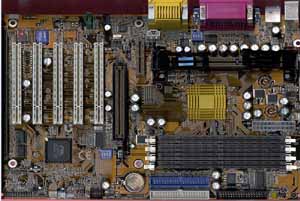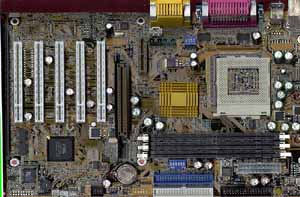VIA Apollo Pro 133/133A Motherboard Roundup - February 2000
by Anand Lal Shimpi on February 28, 2000 1:13 AM EST- Posted in
- Motherboards
Gigabyte GA-6VX-4X & GA-6VX7-4X
|
Motherboard Specifications |
|
| CPU Interface |
Slot-1
|
| Chipset |
VIA Apollo 133A
VIA 694X North Bridge VIA 686A South Bridge |
| L2 Cache |
N/A (on-chip)
|
| Form Factor |
ATX
|
| Bus Speeds |
66
/ 75 / 83
100 / 112 / 124 133 / 142 / 152 |
| Voltages Supported |
Auto Detect - 1.30v - 3.5v
|
| Memory Slots |
4 168-pin DIMM Slots
|
| Expansion Slots |
1
AMR Slots
1 AGP Slot 5 PCI Slots (2 Full Length) 1 ISA Slots (1 Full Length) |
| AC'97 |
Analog Devices 1881
|
| BIOS |
AMI Simple Setup 1.20C
|
Gigabyte submitted two motherboards for the 133A roundup, the GA-6VX-4X and the GA-6VX7-4X, both of which use the 694X and the 686A Super South Bridge. The main difference between the two is that the 6VX-4X is a Slot-1 motherboard while the 6VX7-4X instead offers a Socket-370 interface. Because of the Slot-1 interface, the 6VX-4X has enough room to allow for a fourth DIMM slot on the PCB.
The addition of the fourth memory slot is in full compliance with the 694X North Bridge, which allows for up to 8 memory address lines, therefore allowing for a realistic maximum of 2GB of memory, but the PC133 specification itself recommends that only 1.5GB of memory be used at a 133MHz memory bus frequency. So the fourth DIMM slot on the 6VX-4X can be used, but if you’re planning on maxing out the 2GB memory limit of the 694X North Bridge then you may encounter some stability issues at 133MHz. For most users this won’t be an issue, because it is rare that you find a desktop system using that much memory.
The stability of both of the Gigabyte boards was commendable as was the performance of the two entries, allowing Gigabyte to come away with the Editor’s Choice award for Highest Performance of an Apollo Pro 133A motherboard. While in most situations performance wouldn’t be a big deal, with 133A based motherboards, a balance between performance and stability is often difficult to find.
Luckily, from our tests, Gigabyte seems to have been able to establish that balance quite well as their boards were not only the highest performing in our roundup but also one of the most stable. Gigabyte has generally been known for their stability, and they’ve carried that tradition over to their two latest 133A based products.
One of the biggest problems that we encountered with both Gigabyte boards was that they did not support manual adjustment of the CPU’s core voltage setting. This issue affected the 6VX7-4X even more than the Slot-1 6VX-4X simply because with the Slot-1 board, you can use a Socket-370 to Slot-1 converter to adjust the core voltage or you even go as far as to use the pin-taping method of manually adjusting the core voltage setting, but you can’t do that on a Socket-370 processor.
If you recall, the default voltage of the FC-PGA 500E and 550E CPUs is 1.60v, and often times in order to hit 667/733MHz with these CPUs (see our Overclocking the FC-PGA series for more information) you have to boost the core voltage to around 1.65v or even 1.70v. Without this option, overclocking on the 6VX7-4X becomes very difficult and, while it is also difficult on the Slot-1 6VX-4X, if you’re going to be using a FC-PGA CPU on the board then you’ll have to use a converter card which will most likely feature adjustable core voltage settings on the card itself, thus bypassing this problem.
Both of the boards feature Gigabyte’s DualBIOS feature that allows for one BIOS to take over in the event that your primary BIOS becomes corrupt or the victim of a failed flash attempt.
|
Motherboard Specifications |
|
| CPU Interface |
FC-PGA Socket-370
|
| Chipset |
VIA Apollo 133A
VIA 694X North Bridge VIA 686A South Bridge |
| L2 Cache |
N/A (on-chip)
|
| Form Factor |
ATX
|
| Bus Speeds |
66
/ 75 / 83
100 / 112 / 124 133 / 142 / 152 |
| Voltages Supported |
Auto Detect - 1.30v - 3.5v
|
| Memory Slots |
3 168-pin DIMM Slots
|
| Expansion Slots |
1
AMR Slots
1 AGP Slot 5 PCI Slots (2 Full Length) 1 ISA Slots (0 Full Length) |
| AC'97 |
Analog Devices 1881
|
| BIOS |
AMI Simple Setup 1.20C
|












0 Comments
View All Comments